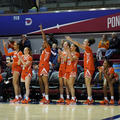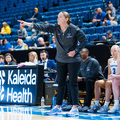Analyzing Syracuse men’s basketball’s new-look roster

Syracuse revamped its lineup after its disappointing 14-19 campaign, retaining just two scholarship players from last year’s roster. Angelina Grevi | Staff Photographer
Get the latest Syracuse news delivered right to your inbox. Subscribe to our sports newsletter here.
Since the transfer portal opened, Syracuse’s roster has completely changed. The Orange’s only returning scholarship players are J.J. Starling and Donnie Freeman, who played seven games together last year. In addition to Eddie Lampkin Jr., Jaquan Carlos, Jyáre Davis, Lucas Taylor and Naheem McLeod graduating, Petar Majstorovic, Chris Bell, Elijah Moore, Kyle Cuffe Jr. and Chance Westry entered the portal. To reconfigure its roster, SU has a top-15 incoming freshman class and added four players from the portal to go alongside Starling and Freeman.
In a pivotal third year at the helm for head coach Adrian Autry, here’s a look at what Syracuse’s new-look roster looks like:
Point guard
Projected starter: Nait George
Projected backups: Luke Fennell, J.J. Starling
One of the Orange’s biggest keys heading into portal season was finding a point guard who can effectively be Starling’s co-star, handle the ball and shoot. They checked that box by gaining a commitment from Nait George, who spent his first two collegiate seasons as Georgia Tech’s starting point guard.
George’s 6.5 assists per game led the Atlantic Coast Conference last year, while his 34.6% assist rate was the 33rd-best in the country. The Toronto native also averaged 12.3 points and knocked down 33.9% of his 3-pointers on 5.2 attempts per game. His points would’ve been the second-best average on SU last year behind Starling (minimum 20 games played), and his 3-point percentage would’ve been second-best among guards, only behind Taylor (36.8%).
Additionally, unlike Carlos last year, George brings valuable ACC experience. In conference play, George increased his points per game average to 13.5 while also averaging 6.5 assists. Meanwhile, George is accustomed to playing most of the game, leading the ACC in his 92.2% percentage of minutes played in conference.
While George should garner most of SU’s point guard minutes, it also has four-star freshman Luke Fennell and Starling, who could slide into the role. Fennell, an Australian native, is a 6-foot-6 combo guard and is playing in the National Basketball League (NBL) as a development player for the South East Melbourne Phoenix.
He also has experience at the NBA Global Academy in Australia. Fennell became Syracuse’s second commit since Alex Kline took over as general manager. With Data Analyst/hybrid coach Eugene Tulyagijja, Kline developed an algorithm to scout talent that helped SU identify the Australian.
At times last year when Carlos was struggling, Starling slid over to the point guard spot. However, it seems unlikely he’ll be needed as a primary ball handler with the additions of George and Fennell.
Shooting guard
Projected starter: J.J. Starling
Projected backups: Kiyan Anthony, Nate Kingz
With George’s addition, Starling will be in line to primarily operate off the ball as a slashing two-guard. Coming off a campaign where he accumulated the 42nd-highest percent shots mark (31.8%) — a KenPom metric that measures a percentage of a team’s shots taken while a player is on the court — in the country en route to a team-high 17.8 points per game, Starling again figures to be the Orange’s No. 1 option.
Though with a much-improved backcourt partner and a trio of other much-improved starting options alongside them, there should be significantly less pressure, and likely fewer shots, for Starling. In games against Power Five opponents where the guard scored under 20 points, SU had a 3-10 record last season. Starling’s scoring will still be pivotal for Syracuse to have success any given night, but it’s now in a much better spot to win even if he doesn’t play at an elite level.
Behind Starling, Kiyan Anthony should get minutes off the bench. Anthony, the son of SU legend Carmelo Anthony, is a four-star recruit standing 6-foot-5 and 185 pounds. The guard is currently playing for Long Island Lutheran (New York) and has played for Team Melo on the EYBL circuit. He’s the second-highest ranked recruit in SU’s 2025 class, slotting in at No. 36 in 247Sports’ rankings.
Additionally, Oregon State transfer Nate Kingz, likely to start at small forward, could slide down to shooting guard depending on lineups.

Lily Zuckerman | Design Editor
Small forward
Projected starter: Nate Kingz
Projected backups: Sadiq White, Aaron Womack
In his first year playing at the Division I level, Kingz became one of the most efficient scoring threats in the country, averaging 11.8 points while shooting 44.6% from 3 on 4.2 attempts per game. His 131.1 offensive rating was the 25th-best in the country, while his 65.3% true shooting percentage ranked 26th.
Beyond his shooting ability, Kingz adds much-needed secondary ball handling and an ability to create for himself off the dribble. Last year, most of SU’s small-forward minutes went to Taylor and Bell, who were good shooters but didn’t provide much else offensively. With Kingz stepping in, the Orange’s offense should be more dynamic with more athleticism, better ball movement and improved shooting.
Depending on lineups, top-rated incoming freshman Sadiq White, an athletic 6-foot-8 wing, will also see minutes at the position. However, with the current roster, he’ll likely slot in at power forward.
Another depth piece the Orange have at the position is three-star freshman Aaron Womack. Like Fennell, Tulyagijja said Syracuse identified Womack with the new algorithm Kline helped create. The 6-foot-6, 170-pound forward plays at Dominican High School (Wisconsin) and chose SU over offers from Buffalo, Green Bay, Illinois State and Illinois-Chicago.
Power forward
Projected starter: Sadiq White
Projected backups: Donnie Freeman, William Kyle III, Ibrahim Souare
White, now playing at IMG Academy (Florida), was a five-star prospect when he committed to the Orange in May 2024 but has since fallen to a four-star. Still, he possesses elite athleticism and versatility Syracuse lacked from its forwards once Freeman was sidelined last season.
Additionally, White told syracuse.com in January he increased his weight from 180 pounds to 200 pounds, and his goal was to increase to 215 by the time he arrived at SU. Currently, White’s defense, interior presence and ability to get downhill are his strengths, while his outside shooting is still developing.
Depending on lineups, Freeman, who was Syracuse’s starting power forward last year until his season-ending injury, will also get minutes at the position. The former five-star recruit and IMG product averaged 13.4 points and 7.9 rebounds across just 14 games.
Following Majstorovic’s decision to enter the portal, Syracuse brought in UCLA transfer William Kyle III and Georgia Tech transfer Ibrahim Souare. They’re both listed at 6-foot-9, while Kyle is 230 pounds and Souare is 225. Beyond their comparable frames, the duo provides similar skill sets as undersized bigs who can run the floor and protect the rim.
Center
Projected starter: Donnie Freeman
Projected backups: William Kyle III, Ibrahim Souare
Listed at 6-foot-9, Freeman is the tallest player on Syracuse’s roster alongside Kyle and Souare. Though a natural forward, Freeman received some minutes at center last year when he was on the court without Lampkin. With SU’s current roster makeup, sliding Freeman to the center spot allows Autry to start his best five players.
Freeman playing primarily at center would give Syracuse a much different look from Lampkin, who was a traditional back-to-the-basket bruising big who struggled drastically on the defensive end. While Freeman doesn’t have a typical center build, his length can help him near the basket, and his athleticism will allow him to guard one through five. Last year, on the contrary, the Orange often hedged ball screens to avoid Lampkin having to guard anyone on the perimeter.
Kyle and Souare provide similar defensive traits, but both of their offensive repertoires are far off Freeman’s, who can handle the ball, score inside and knock down 3-pointers. Playing 9.6 minutes per contest with the Bruins last season, Kyle averaged 2.9 points while shooting 70.4% from the field on 1.7 attempts per game, with his scoring almost exclusively coming near the rim.
Meanwhile, Souare was right behind Kyle with 2.8 points, converting 59.7% of his field goals on 2.1 attempts across 17.0 minutes per game. Both players are pretty much the opposite of Lampkin, more so thriving on the defensive end, while their athleticism helps them contribute on offense.






